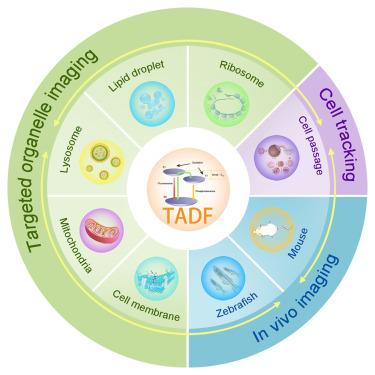基于热激活延迟荧光的高性能探针增强生物成像
IF 4.1
2区 综合性期刊
Q1 MULTIDISCIPLINARY SCIENCES
引用次数: 0
摘要
热激活延迟荧光(TADF)材料由于其高量子效率和抑制短寿命背景荧光的能力而在生物成像领域受到了极大的关注。本文综述了近年来有机TADF探针的研究进展,重点介绍了它们的光物理机制、结构设计和封装策略,以提高生物相容性和光稳定性。我们强调了它们在细胞器靶向成像,动态活细胞跟踪以及斑马鱼和小鼠等模式生物的体内成像中的应用。此外,我们还讨论了当前的挑战,包括氧敏感性和有限的长期稳定性。高性能TADF探针的开发有望提高成像质量,促进更深层次的组织渗透,并支持长期的细胞研究,从而为生物医学研究和诊断成像做出重大贡献。本文章由计算机程序翻译,如有差异,请以英文原文为准。

Enhancing biological imaging with high-performance probes based on thermally activated delayed fluorescence
Thermally activated delayed fluorescence (TADF) materials have gained significant attention in biological imaging due to their high quantum efficiency and capacity to suppress short-lived background fluorescence. This review comprehensively analyzes recent advancements in organic TADF probes, focusing on their photophysical mechanisms, structural design, and encapsulation strategies to improve biocompatibility and photostability. We highlight their applications in organelle-targeted imaging, dynamic live-cell tracking, and in vivo imaging in model organisms such as zebrafish and mice. Additionally, we discuss current challenges, including oxygen sensitivity and limited long-term stability. The development of high-performance TADF probes promises to enhance imaging quality, facilitate deeper tissue penetration, and support long-term cellular studies, thereby contributing substantially to biomedical research and diagnostic imaging.
求助全文
通过发布文献求助,成功后即可免费获取论文全文。
去求助
来源期刊

iScience
Multidisciplinary-Multidisciplinary
CiteScore
7.20
自引率
1.70%
发文量
1972
审稿时长
6 weeks
期刊介绍:
Science has many big remaining questions. To address them, we will need to work collaboratively and across disciplines. The goal of iScience is to help fuel that type of interdisciplinary thinking. iScience is a new open-access journal from Cell Press that provides a platform for original research in the life, physical, and earth sciences. The primary criterion for publication in iScience is a significant contribution to a relevant field combined with robust results and underlying methodology. The advances appearing in iScience include both fundamental and applied investigations across this interdisciplinary range of topic areas. To support transparency in scientific investigation, we are happy to consider replication studies and papers that describe negative results.
We know you want your work to be published quickly and to be widely visible within your community and beyond. With the strong international reputation of Cell Press behind it, publication in iScience will help your work garner the attention and recognition it merits. Like all Cell Press journals, iScience prioritizes rapid publication. Our editorial team pays special attention to high-quality author service and to efficient, clear-cut decisions based on the information available within the manuscript. iScience taps into the expertise across Cell Press journals and selected partners to inform our editorial decisions and help publish your science in a timely and seamless way.
 求助内容:
求助内容: 应助结果提醒方式:
应助结果提醒方式:


